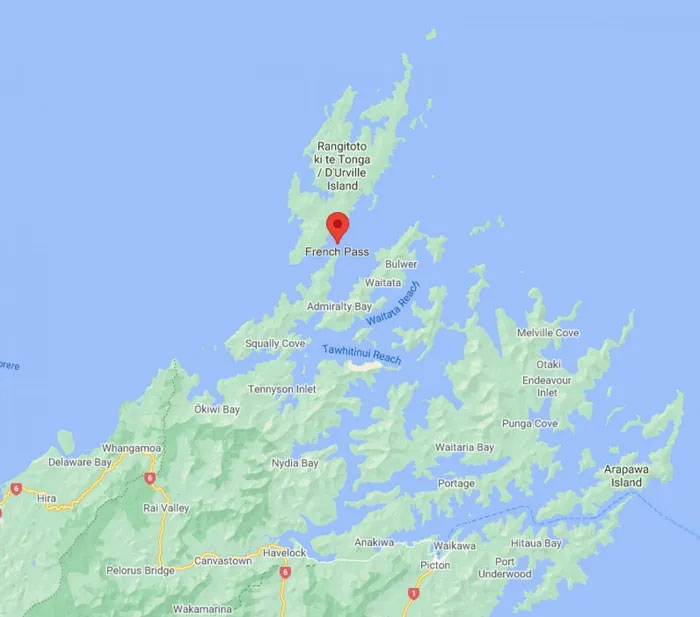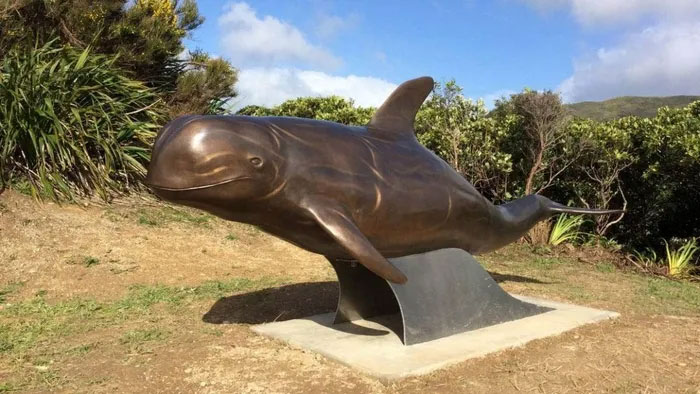New Zealand became the first country in the world to grant legal protection rights to a marine creature, with the dolphin Pelorus Jack, who guided ships through the waters of New Zealand for 24 years, being the first marine animal to be honored and protected by law.
In 1642, explorer Abel Tasman became the first European to discover a group of islands in the South Pacific, which would later be known as New Zealand. In 1840, the British began their conquest and officially annexed the archipelago by establishing a long-term European settlement in Wellington.
Since then, numerous trade routes have been established to transport minerals and gemstones mined from these islands. The only issue was the narrow straits connecting the islands, which made it very difficult for ships to navigate. Strong currents pushed vessels into rocks, causing damage, as sailors could not determine the locations of whirlpools.

Image of dolphin Pelorus Jack. (Source: historyofyesterday.com).
The Savior Appears
The ships of the 19th century were sturdy but still could not compete with “Mother Nature.” Dolphins were often sighted off the northern coast of New Zealand, but there was one particular dolphin that sailors regarded as a true savior. The dolphin was first spotted in 1888 when a merchant ship was approaching French Pass, a notoriously dangerous strait between D’Urville Island and the South Island, situated on the route between Wellington and Nelson.
When the crew members saw the dolphin bobbing up and down in front of the ship, they initially wanted to kill it, but the captain’s wife intervened. To their surprise, the dolphin then guided the ship safely through the narrow channel. The dolphin led the vessel through swirling waters and past French Pass safely.
The sailors nicknamed the dolphin Pelorus Jack, related to the Marlborough Sounds area where Jack waited to guide ships. Jack was approximately 4 meters long with gray stripes or shades and a round white head. The sex of the dolphin was never confirmed; however, researchers believe it was male based on the size of the marine mammal. For many years thereafter, Jack guided almost every ship safely through French Pass.
Pelorus Jack would swim alongside the vessel for about 20 minutes each time, appearing both day and night. With rocks and strong currents, the area was very dangerous for ships, but no shipwrecks occurred while Jack was present. Pelorus Jack was extremely accurate and courageous, turning waves right in front of ships and guiding them. After a few years, sailors would not even attempt to pass through French Pass if Jack had not arrived to “lead the way.”

French Pass. (Source: historyofyesterday.com).
Jack became famous worldwide after an article published by the Daily Mail in 1906.
“For the past 20 years, no ship has passed through this area without a ‘companion,’ at least for part of the journey, which is a large white dolphin known as Pelorus Jack.… The first time it was noticed, it leaped out of the water from afar, but for a moment it swam right in front of the ship. Sometimes it would leap out of the water for just a moment and swim ahead, then dart out of sight. But at other times, it would stay for more than 10 minutes. Jack is said to never approach sailing ships or steamers with wooden hulls; however, whenever a steel-hulled steamer crossed the Sound, whether day or night, Pelorus Jack was always there to assist,” the Daily Mail article stated.
Famous writers such as Mark Twain and Frank Bullen sailed to French Pass just to catch a glimpse of Jack and briefly mentioned this remarkable dolphin in their works.
Fame Accompanied by Hatred
An interesting event occurred in 1904 when a passenger on the SS Penguin (one of the first steam-powered ships in New Zealand) attempted to shoot Pelorus Jack while the dolphin was guiding the ship. The man was arrested on board but was released upon reaching land, as there were no laws at that time prohibiting people from shooting dolphins.
Despite the danger, Pelorus Jack continued to assist ships, but the next time the SS Penguin passed through French Pass, Jack was nowhere to be seen. This was because the dolphin recognized that this particular ship posed a threat.
Pelorus Jack never “led the way for the SS Penguin again, and the ship struck a rock, sinking off the South Wellington coast shortly thereafter. It is believed that a ship abandoned by a dolphin would eventually meet disaster. More than 75 passengers on board perished, and this was certainly avoidable had Jack been there to guide them.

Statue honoring dolphin Pelorus Jack. (Source: stuff.co.nz).
On September 26, 1904, authorities signed an order banning the harm of Risso’s dolphins in and around New Zealand. This order was issued following the incident involving the SS Penguin and made New Zealand the first country in the world to grant legal protection rights to a single marine creature, with Jack being the first marine individual protected by law. In the New Zealand archives, there is a clip showing Pelorus Jack guiding a ship. Many people do not truly believe the story of Jack, thinking it is merely a legend imagined by sailors, but the clip is the only detailed information about the existence of this famous dolphin.
A Mysterious Death
In April 1912, Pelorus Jack mysteriously disappeared. Ships waited for Jack for many days but saw no sign of him. It is unclear exactly what happened to Jack, but it seems that he may have died. At that time, it was believed that Jack had collided with a ship’s hull and was cut in half. This is entirely plausible as he was always right beside the hull when guiding them.
Other theories suggest he may have been shot by someone out of hatred. Others say that during that time, many Norwegian fishermen came to New Zealand and began catching everything they saw moving, so Jack might have been caught by fishermen. Another theory could simply be that Jack died of natural causes. Risso’s dolphins typically live for 20 to 40 years, and Jack spent 24 years of his life (1888-1912) guiding ships through French Pass.
Jack certainly made a significant impact on the lives of many people. The legend of Pelorus Jack continues to resonate in today’s world. Since 1989, Pelorus Jack has been used as a symbol for Interislander, a ferry service running between Wellington and Picton across Cook Strait. A chocolate brand has also been named after him. In 2016, a life-sized bronze sculpture was erected at Collinet Point, overlooking French Pass, to honor Jack.


















































